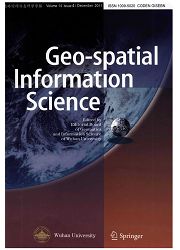Feasibility of Estimating Heavy Metal Contaminations in Floodplain Soils Using Laboratory-Based Hyperspectral Data~A Case Study Along Le'an River, China
作者:LIU Yaolin,LI Wei,WU Guofeng,XU Xinguo
摘要:It is necessary to estimate heavy metal concentrations within soils for understanding heavy metal contaminations and for keeping the sustainable developments of ecosystems.This study,with the floodplain along Le'an River and its two branches in Jiangxi Province of China as a case study,aimed to explore the feasibility of estimating concentrations of heavy metal lead(Pb),copper(Cu) and zinc(Zn) within soils using laboratory-based hyperspectral data.Thirty soil samples were collected,and their hyperspectral data,soil organic matters and Pb,Cu and Zn concentrations were measured in the laboratory.The potential relations among hyperspectral data,soil organic matter and Pb,Cu and Zn concentrations were explored and further used to estimate Pb,Cu and Zn concentrations from hyperspectral data with soil organic matter as a bridge.The results showed that the ratio of the first-order derivatives of spectral absorbance at wavelengths 624 and 564 nm could explain 52% of the variation of soil organic matter;the soil organic matter could ex-plain 59%,51% and 50% of the variation of Pb,Cu and Zn concentrations with estimated standard errors of 1.41,48.27 and 45.15 mg·kg-1;and the absolute estimation errors were 8%-56%,12%-118% and 2%-22%,and 50%,67% and 100% of them were less than 25% for Pb,Cu and Zn concentration estimations.We concluded that the laboratory-based hyperspectral data hold potentials in esti-mating concentrations of heavy metal Pb,Cu and Zn in soils.More sampling points or other potential linear and non-linear regression methods should be used for improving the stabilities and accuracies of the estimation models.
发文机构:School of Resource and Environmental Science. Wuhan University Key Laboratory of Geographic Information System Sichuan Zhongshui-chengkanyuan Surveying and Mapping Engineering Company
关键词:soilheavy metal concentrationestimationsoil organic matterhyperspectral data
分类号: P208[天文地球—地图制图学与地理信息工程][天文地球—测绘科学与技术]
- Retrieval of Brown Carbon based on the aerosol complex refractive indices in the winter of Wuhan
- Remote Sensing and GIS Application in the Detection of Environmental Degradation Indicators
- High-resolution Hyper-spectral Image Classification with Parts-based Feature and Morphology Profile in Urban Area
- Building 3D Cadastral System Based on 2D Survey Plans with SketchUp
- Skyline-Based Registration of 3D Laser Scans
- Atmospheric Excitation of Polar Motion
- Design and Implementation of 3D Model Database for General-Purpose 3D GIS
- Modeling and Sensitivity Analysis of Navigation Parameter Errors for Airborne Synthetic Aperture Radar Stereo Geolocation
- Integrating Terrain and Vegetation Indices for Identifying Potential Soil Erosion Risk Area
- Doppler Properties of Spaceborne/Airborne Hybrid Bistatic Synthetic Aperture Radar


